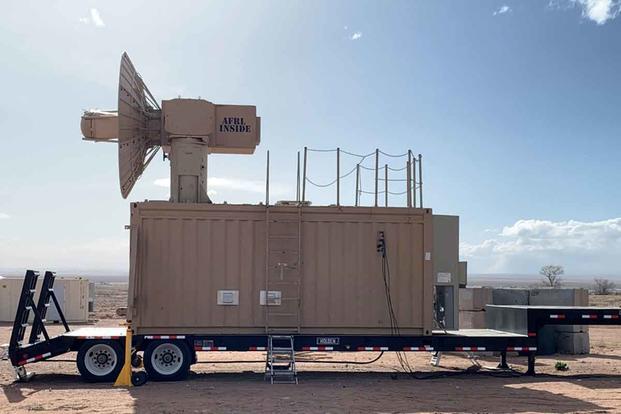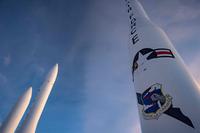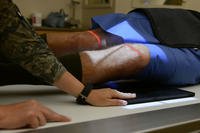The Army's newest operational laser weapon may be undergoing testing in the Middle East, but the top general responsible for U.S. troops in the region is already looking ahead to bigger and better directed-energy systems amid a rising tide of adversary drones.
Speaking during a Senate Armed Service Committee hearing on Thursday, U.S. Central Command chief Gen. Michael "Erik" Kurilla argued that lawmakers should continue to invest in directed-energy weapons like high-powered microwaves rather than just high-energy lasers to combat the potential future threat of drone swarms.
"The bigger concern is if you start talking about swarms, so we need to continue to invest in things like high-powered microwave [sic] to be able to counter a drone swarm that is coming at you," Kurilla said. "I mean, nothing is 100%. And at some point, the law of statistics will come up to you. You have to have layered defense."
Read Next: Ospreys Cleared to Fly Again After Deadly Crash Despite Mechanical Failure with Unknown Cause
High-energy laser weapons are designed to defeat incoming drones and missiles by employing a narrow beam of energy to burn incoming threats out of the sky. In contrast, high-powered microwaves create a cone of electromagnetic interference that disables electronics across both a wider area and a wider range of target systems, according to the latest Congressional Research Service report on directed-energy weapons.
While lasers provide point defense against individual drones, microwave weapons are widely considered a more effective blanket defense across a broader area, making them suited to deal with complex attacks involving swarms of multiple fast-moving drones.

The Defense Department is working on at least 31 directed-energy projects at the moment (and funding them to the tune of $1 billion a year, according to a 2023 report from the Government Accountability Office). However, only a handful of projects focus on employing high-powered microwaves.
Those weapons include the Army's Indirect Fire Protection Capability-High-Power Microwave, or IFPC-HPM, weapon developed by Epirus, which the service first took possession of in November; the Air Force's Tactical High-Power Operational Responder, or THOR, which faced off against a drone swarm in a first-of-its-kind test last May; and the Counter-Electronic High-Power Microwave Extended-Range Air Base Defense, known as CHIMERA, which is mostly classified.
While the THOR underwent an initial "real-world" test in Africa in 2020, none of the DoD's high-powered microwave systems appears ready for an actual operational deployment, according to publicly available information gathered by the CRS.
Low-cost attack drones, which Central Command leaders consider the greatest threat to U.S. service members in the region since the improvised explosive device, have increasingly plagued troops deployed to outposts in Iraq and Syria and warships in the Red Sea, where Iran-backed militias have taken shots at American forces following the outbreak of Israel's war with Hamas in Gaza.
One attack on a U.S. military base in Jordan killed three U.S. service members in January; as of February, there had been 186 U.S. casualties in Iraq, Syria and Jordan, including more than 130 traumatic brain injuries, according to the Defense Department.
Speaking to lawmakers during the Senate hearing on Thursday, Kurilla emphasized that incoming drones have come uncomfortably close to injuring or even killing more troops.
"There are several incidents where [drones] coming into a base hit another object, got caught up in a netting or other incidents where, had they hit the appropriate target that they were targeting, it would have injured or killed service members," Kurilla told lawmakers.
While the Army has sent Directed Energy Maneuver-Short Range Air Defense, known as DE M-SHORAD, to the Middle East for an operational experiment -- Stryker infantry carrier vehicles outfitted with 50-kilowatt "Guardian" laser weapons -- it's Navy surface warfare leaders who are putting pressure on the DoD to furnish warships with directed-energy weapons rather than forcing them to rely on relatively costly missiles to take out incoming drones and anti-ship ballistic missiles.
Only one Navy warship, the Arleigh Burke-class destroyer USS Preble, is currently outfitted with one 60-kilowatt High-Energy Laser with Integrated Optical-Dazzler and Surveillance system, which is known as HELIOS.
"What we're facing in the Red Sea is more than just drones. We're looking at land-attack cruise missiles, we're looking at anti-ship ballistic missiles that are getting shot in the Red Sea by the Houthis. And our ships are dealing with all of those," Naval Surface Forces commander Vice Adm. Brendan McLane told reporters in January. "One of the things that I think we really need to get after quicker is we need to accelerate the development of directed-energy weapons, whether it's a laser, whether it's a microwave."
Kurilla echoed McLane's comments on Thursday, stating that he "would love to have the Navy produce more directed-energy [weapons] that can shoot down a drone, so I don't have to use an expensive missile to shoot it down."
Related: Luck Has Prevented More US Casualties from Drone Attacks in Iraq and Syria, Top Mideast General Says















